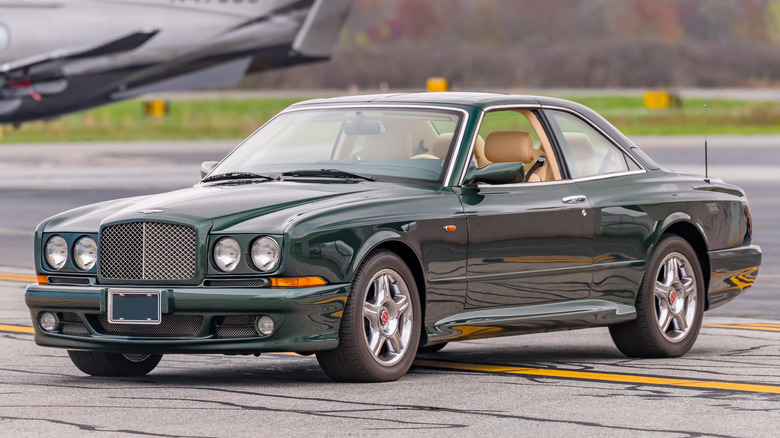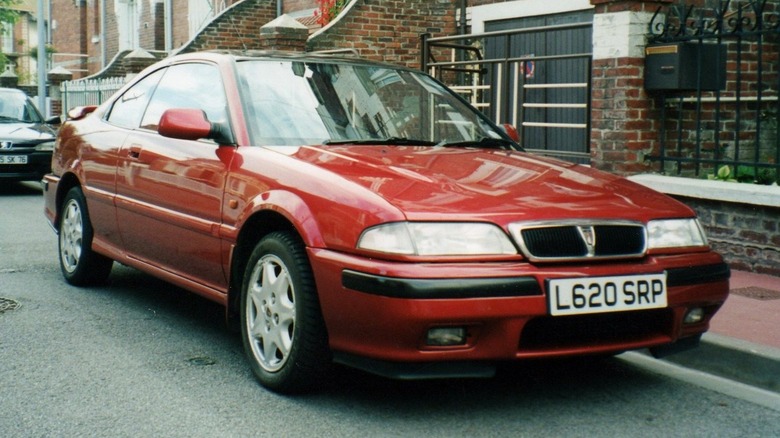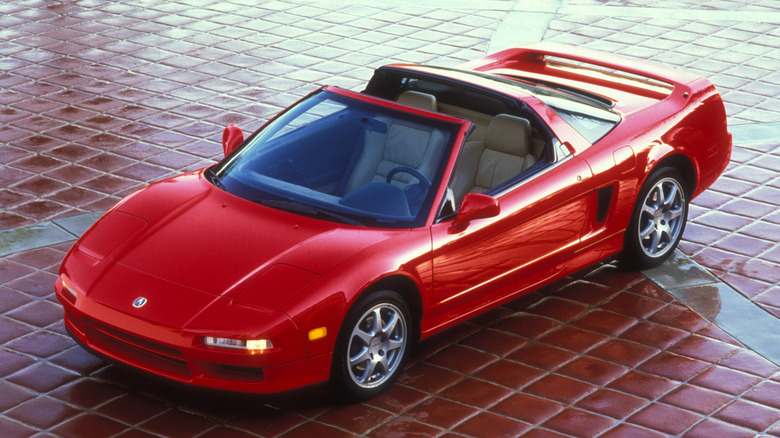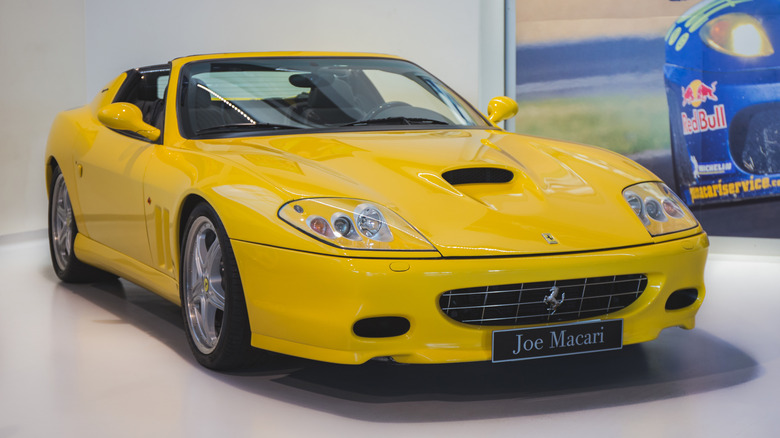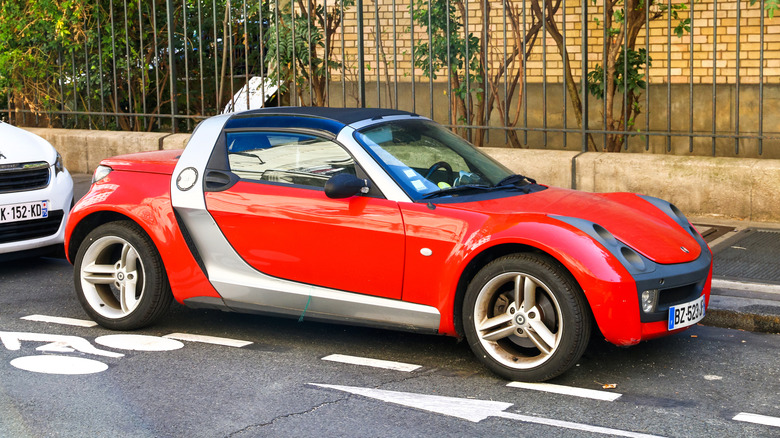10 Iconic Targa Top Cars You Probably Didn't Know Existed
There's a good reason why the Porsche 911 Targa is the most famous car to bear the Targa name. It's simply because it has to be — Porsche owns the "Targa" trademark, even though the term has become commonly used to refer to a variety of cars with removable roof panels. While Porsche's iconic sports car wasn't the first to use such a roof design, it was the most notable, and so the name caught on. That presented a challenge for other manufacturers: how best to refer to their new cars' removable roofs without infringing on Porsche's trademark.
Each manufacturer differed in its strategy — some referred to "T-top" roofs, while others invented an entirely new name for the design. These new names never eclipsed the original Targa name in common usage, even though a number of well-known enthusiasts' favorites featured the roof over the decades. From Toyota to Ferrari, the Targa-style roof has appeared on plenty of notable classics, although some enthusiasts might have never realized that these cars had such roof options available.
Toyota Sports 800
It's easy to overlook just how important the Toyota Sports 800 was to the Japanese automaker. Several years before the 2000GT kickstarted Toyota's sports car revolution, the Sports 800 represented the brand's first tentative steps into the world of automotive performance. It was unveiled in concept form in 1962 and launched in production form in Japan in April 1965. Notably, that was several months before the original Porsche 911 Targa was unveiled in September 1965.
Unlike Porsche, Toyota didn't have a dedicated name for its roof at the time, although its function was very similar to that of the later 911. The Sports 800's roof panels could be removed and stored in the trunk of the car, with those panels made of aluminum to help keep the car's weight to a minimum. This was particularly important since the Sports 800's engine only produced a modest 45 horsepower. The car was successful in Japan, with more than 3,000 examples built before production ended in 1969. According to the brand, only 10% of that original production run is thought to survive today.
Bentley Continental SC
One of the rarest Bentleys of its era, the Continental SC was built for just three model years between 1998 and 2000. Only 73 examples were built in total, with the price for each reportedly exceeding $360,000. This rarity has helped it retain much of its value over the decades, too — an example that had previously been involved in a crash still sold for $240,000 at a Bonhams auction in 2024.
The SC, or Sedanca Coupé, was closely related to the renowned Continental T, with the main difference being its unique roof. It featured a 6.75-liter V8 engine with over 400 horsepower on tap, mated to a four-speed automatic transmission. Like any other Bentley of the era, it was designed to be quiet, refined, and traditional, and as such, the interior was filled with liberal amounts of fine leather and wood trim.
Unlike its stablemates, the SC's cabin could be exposed to the elements thanks to the removable glass panels that made up the Targa roof. When they weren't affixed to the car, they were designed to be stored in the trunk. Only the front two seats benefitted from the Targa roof, with rear seat passengers instead left with a fixed glass roof.
Rover 200 Coupe
Although its build quality and refinement never matched up to its German competition, the Rover 200 Coupe already had plenty of fans in the UK by the time it launched in 1992. Shortly before its launch, the British brand had put it through its paces at Millbrook Proving Ground, where the car racked up an impressive 37 speed records for its class. The automaker billed it as the fastest Rover ever built, but that wasn't the only selling point.
Also featured was a Targa-style roof, with removable glass panels and compartments in the trunk of the car to hold them. Combined with the Rover's good looks, the car promised a lot, although it couldn't quite deliver on all of its promises. Patchy build quality meant that the Targa-style roof frequently rattled, and its ride didn't match its admirable performance. Nonetheless, the car sold well and remains a fanbase in its home country today, even if it's largely unknown in other parts of the world.
[Featured image by Mic via Wikimedia Commons | Cropped and scaled | CC BY 2.0]
Acura NSX-T
The hardtop NSX had already made its mark on the automotive landscape by the time the NSX-T was unveiled in 1995. The original had proved that Japanese supercars were to be taken seriously, boasting not only unique technical innovations but also the looks and performance to put them on par with European rivals. The NSX-T was intended to reinforce those Euro-rivaling credentials, offering a new roof with removable panels that was a Targa in all but name.
Porsche's trademark of the word meant that Acura instead referred to its Targa-topped variant with a single letter, "T." Both the NSX and NSX-T sported an identical powertrain, namely a 3.0-liter V6 making a maximum of 270 horsepower in manual guise. Acura was careful to note in its press material that the NSX-T had been subject to additional chassis reinforcements to compensate for the structural rigidity lost by the addition of the new removable roof, and so buyers could look forward to the same precise handling that the hardtop car had become famous for.
Suzuki Cappuccino
The Suzuki Cappuccino is one of the most famous kei sports cars of its era, being one of the "ABC" trio alongside the Autozam AZ-1 and Honda Beat. It's primarily famous for its tiny size and correspondingly tiny engine: thanks to Japanese regulations, it's limited to 660cc, and officially puts out 64 horsepower. Less famous is its unusual roof, which features a trio of panels that can be stored away when not in use. Suzuki designed special roof panel bags to protect them from the elements; some collector cars still use those bags.
The Cappuccino is a relatively rare car, with around 28,000 examples leaving the factory, but a unique looks and unusual engine and layout have ensured that it remains a sought-after collectors' item today. Many remain in Japan, but imported examples occasionally appear on sites like Bring a Trailer with temptingly affordable price tags.
Toyota Supra Sport Roof
The A80 generation Supra is one of the most famous T-top cars, but the previous A70 generation is not as well-remembered. The T-top variant was unveiled in June 1986, just a few months after the generation's launch. Toyota noted that the T-top benefitted from body reinforcements to "ensure precise handling and running stability." A choice of three engines were offered with the car: a 3.0-liter turbo, a 2.0-liter twin-turbo, and a naturally aspirated 2.0-liter engine. Like other Targa-style cars, the Supra Sport Roof featured a space in the trunk to store roof panels when they weren't in use.
The A70 Supra first reached American shores the same year, going head to head with both domestic rivals and those from elsewhere in Japan and Europe. It never took off in the same way its successor eventually would, and as a result, some enthusiasts might not have even heard of the steel-paneled T-top variant. Its overlooked status continues today, at least in comparison to the A80/Mk4 Supra, which has become one of the most revered JDM cars ever made.
[Featured image by Greg Gjerdingen via Wikimedia Commons | Cropped and scaled | CC BY 2.0]
Vauxhall VX220/Opel Speedster
There are plenty of famous GM T-tops, but one of the automaking giant's lesser-known products also featured a removable Targa-style roof. The Vauxhall VX220, known as the Opel Speedster in Europe, was a short-lived sports car based on the Lotus Elise. It shared few parts but was co-developed and built by Lotus and designed to be just as fun to drive. It was slightly less bare-bones than the Elise and intended to be less uncomfortable on the road, but it never sold well during its production lifespan despite its low-slung proportions and Elise-style removable roof, which could be stored in the trunk on sunny days.
A key reason for the slow sales was its badge — the Vauxhall marque, essentially GM's British arm at the time was more associated with economy cars and minivans than sports cars. It certainly didn't carry anywhere near the prestige of the Lotus badge despite offering a sports car that was similarly priced. As a result, it remains a rarity today, even in its home country.
Ferrari 575M Superamerica
While not an entirely conventional targa, the roof of the Ferrari 575M Superamerica is similar enough to warrant inclusion here. The roof panel is made from electrochromic glass, and its opacity can be controlled electronically. When the driver pushes a switch, the glass turns lighter or darker, effectively acting as a conventional opaque roof in its darkest setting and as a sunroof in its lightest.
When the roof isn't needed at all, it can be stored away in a compartment behind the seats. Strangely enough, despite the electronic mechanism to pull the roof panel behind the seats, a manual latch still needs to be engaged to keep the panel there while driving. Perhaps it's a little more like a traditional Targa than it first appears.
The 575M Superamerica is rare and expensive, with only 559 examples built during its production run. Each was sold before a single car was delivered and so anyone who isn't a Prancing Horse aficionado can be forgiven for forgetting it exists — if they knew about it to begin with.
Smart Roadster
Undoubtedly one of the most unusual sporty cars of its era, the Smart Roadster took a similar approach to Japanese kei sports cars in that it offered very little power to back up its looks. However, since it was so compact and lightweight, it was zippier to drive than many might expect by looking at its spec sheet. A 0.7-liter engine with around 80 horsepower doesn't sound like a recipe for a fun time, but more than 43,000 buyers disagreed. That number may well have been higher were it not for some serious quality control issues with the car.
The car was available with either a soft-top or Targa-style panels, but both were prone to leaks. Several other places around the car also emerged as hotspots for leaks, sometimes causing damage to its electrical systems and requiring costly repairs. The Roadster's transmission was also another weak point, being regarded as unacceptably sluggish for a supposedly sporty car. Even with these flaws, the Roadster carved out a niche following, although since it was never sold in America, it remains forbidden fruit for now.
Maserati Khamsin
A lot of buyers have liked T-tops. A few buyers have loved them. Fewer still loved them enough to create a T-top car for themselves, but only one buyer is known to have created a custom T-top from a Maserati Khamsin. That custom Khamsin appeared at a Bonhams auction in 2015, eventually selling for €195,500 (around $236,000 at the time). According to the listing, the car's roof was converted before it was delivered to its first owner, with the work carried out by an unknown shop in California.
The buyer of the car also resided in California and owned it for around a decade before selling it on. The T-top was designed to make the most of the state's sunny climate, with its removable panels being made of tinted glass to ensure the cabin could be kept cool when the roof was fitted. Per Bonhams, the car was originally set to be considered for official Maserati homologation, but doing so would have meant shipping the car back to Italy, which the dealer declined to do. Maserati never officially made a T-top Khamsin, even though this one-off example took part in the brand's 90th-anniversary celebrations and was sold new from an authorized Maserati dealer with its unique roof.
